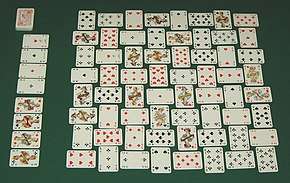Crazy Quilt (solitaire)
Crazy Quilt (also known as Indian Carpet and Japanese Rug) is a solitaire card game using two decks of 52 playing cards each.[1] The game is so-called because the reserve resembles the weaves of a carpet or an arrangement of a quilt, with cards alternating vertical and horizontal rotations. The arrangement of the cards on the reserve is also the reason it is rarely seen on computer solitaire packages, most of which have their cards placed vertically.

First, one Ace and one King of each suit are taken out to form the foundations. The rest of the cards are shuffled, and 64 cards are dealt into eight rows of eight cards each. The first row should have its first card placed vertically, the second placed horizontally, the third vertically, the fourth horizontally, and so on. The second row should have its first card placed horizontally, its second one vertically and so on. The resulting layout resembles a checkerboard with vertical and horizontal cards alternating. This reserve is called the "quilt."
The cards on the quilt with their shorter sides exposed, i.e. cards each with one of its shorter sides not touching another card, are available for play to the foundations or the top of the wastepile. The foundations that start with the Aces are built up by suit while those that start with the Kings are built down also by suit.
The stock is dealt one at a time onto the wastepile. The top card of the wastepile can be used to build on the foundations and be built up or down by suit using cards from the quilt.
Once the stock runs out, the wastepile (which includes cards acquired from the quilt) is gathered and turned faced down without shuffling to be used as the new stock. This can be done only once in the entire game.
The game is won when all cards, both from the quilt and the wastepile, end up in the foundations.
See also
References
- Parodi, Francesca (2004). Big Book of Solitaire. Sterling Publishing Company, Inc. ISBN 978-1-4027-0944-9.
